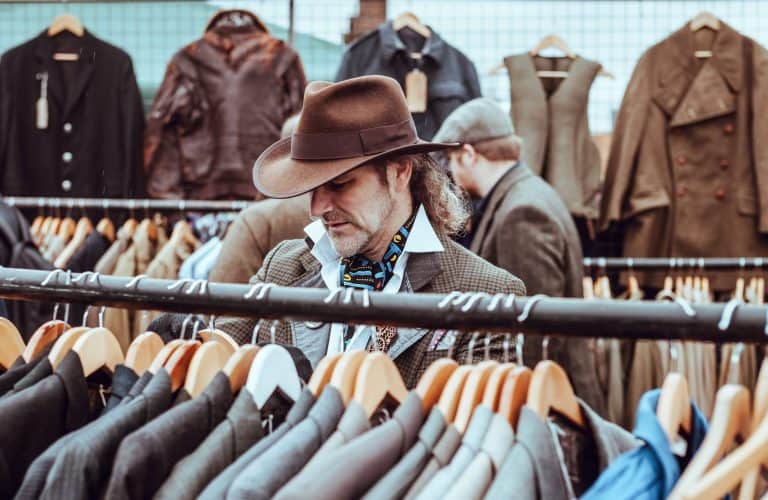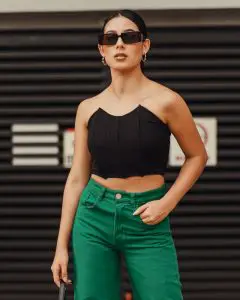Introduction
Have you ever wondered how much your closet is worth? If you have ever bought clothes from a boutique, antique shop, garage sale, thrift store, or raided your parents/grandparent’s closets, there is a good chance you might possess some valuable pieces!
If you have a love for vintage clothing and want to put that passion to work, or you are simply looking to earn money, then investing in vintage pieces may be for you. Depending on the piece, you’ll want to consider preserving, repairing or possibly reselling to vintage collectors.
In this post, we’re going to teach you how to identify and appraise vintage clothing, where to find vintage pieces, and where to sell these pieces.
1. Defining Vintage Clothing
2. How to Identify Vintage Items
3. How to Valuate & Price Your Vintage Items
4. Where to Find & Sell Your Vintage Clothing
5. Conclusions
1. Defining Vintage Clothing
When thinking of vintage clothing, many people might think it is limited to fashion from the 1960s or prior. Others may think of vintage clothing as outdated or “dead” styles from the past. So, what exactly is vintage fashion?
Vintage fashion is the exceptionally constructed apparel from the past, typically before the 1990s. Vintage clothing has a rarity value attached to it and meets standards of visually appealing qualities. These standards, along with value and price are determined by markets and experts.
Many people consider vintage clothing as apparel that has survived years of age and is in good condition. Vintage clothing is any piece from the past, but that does not always mean all pieces the same in age will hold the same value. For example, over wearing a piece may deteriorate it, lowering its value. We’re going to cover these differences later in this post.
At the moment, the demand for vintage clothing is remarkably strong, with no signs of slowing down. If a piece is very fine, in a museum-quality state, an early or pivotal illustration of a designer’s career, and fits with modern trends, it sells and sells fast.
Much of the explanation why vintage is so enticing and remains so, is that it is in genuinely finite stock. Maybe 30 or so years ago, only the eccentric and determined collector would track down pieces. Now, the competition for acquiring these unique, nostalgic, pieces of history, is high.
Are you thinking you might have some vintage pieces in your closet? Keep reading learn key vintage indicators and how to evaluate a product’s worth.
2. How to Identify Vintage Items
Identifying vintage clothing can sometimes be tricky. Certain features, like fabric type and texture, are more noticeable to seasoned vintage fashion experts than the new collector. Other features, like tags, make vintage pieces clearly stand out.
- Tags: Tags are some of the most obvious indicators you have a vintage piece.
-
- Copyright Year: The year of copyright is not the year in which the item was made, but the year in which the brand was copyrighted. You can say that the clothes were made in the same year or a few years later. Any clothing made before 1992 is considered to be a vintage garment.
- Made in USA Label: The US produces a very small percentage of apparel. If there is a “Made in the USA” label or a picture of an American flag, it is possible you are looking at a piece produced prior to the 1980s. If you see an American flag or the words “Made in the USA” on the front of the tag, it’s more than likely the clothing piece was made prior to the ’80s.
- Wool Labels & Logos: If you have a wool coat and you don’t have a sticker that marks it like wool, it was manufactured before 1939. In 1964, producers started putting a wool logo on their clothing. It was used as a marketing campaign tactic to encourage buyers to buy wool instead of polyester. The first Wool Label was used in 1964 and signifies the product is 100% wool. The second and third logos, dated from 1971 to 1999, badge represent a mix of 60% wool and a blend of 50% wool.
- Address: Prior to the mid-1960s, zip codes were not used in addresses. Many popular clothing manufacturers in New York and other major cities, used the city an street name. If you only see these two address markers, you’re likely like at a garment made before the 1960s.
- Look & Feel: Vintage and modern clothing often have differences in feel, texture, and patterns. If you are new to vintage appraising, this might be more difficult to recognize. There’s often a texture difference between vintage and modern clothing. A good way to practice is by comparing your clothing you know is vintage with the other pieces in your closet.
- Features: Pinked seams, metal zippers, and closures with side-snaps are common features for vintage pieces from the 1920s-1960s. From the ’30s to ’40s, metal zippers were most likely placed on the side of the garment. Pinked seams were very common in the 1950s. The seam looks like teeth, designed to reduce fraying. If you notice the seams are not completed, you may have a garment from manufactured before the 1950s. Sergers were not popular amongst seamstresses at that time.
Now that you have learned how to identify vintage clothes, let’s learn how to valuate, or estimate their worth and quality.
3. How to Valuate & Price Your Vintage Items
One of the most challenging parts of selling vintage clothing in appraising its value and determining an appropriate price to sell it for. You may come across garments that are more rare, others that are more valuable, and some that are going to require additional investment if you plan to make money reselling.
Because vintage clothing does not fit into one category, there is not one specific algorithm or formula to use. That is the beauty of vintage clothing and its uniqueness!
You will have to account for how much you paid for the piece, the time and money invested to repair for sale, and the current market prices of similar items. Here are a few additional factors to consider when valuating your vintage closet collection:
- By Time Period: Appraising your item according to the era it was created may seem like common sense. Of course, if we’re talking about vintage clothing, this is an important factor! Many luxury goods not only retain value well over time but increase in value. For example, the exclusive Birkin Bag is forecasted to double in value in the next 10 years. However, older does not equal more valuable in every case. Keep in mind, a dress from the ’30s — while more exclusive in quantity — may hold a “purchasing” value less than a dress from the ’80s. You’ll want to evaluate the item’s age and compare it to modern trends, how available it is and the designer or brand’s legacy, all of which we’re going to cover below.
- By Brand & Designer: Vintage pieces designed by the top luxurious and recognizable houses are going to be some the most valuable. Exclusive, seasonal runway collections are even more valuable, due to their limited availability. To assess whether your vintage piece originated from a stylish collection, compared to a ready-to-wear collection sold in department stores, you’ll likely need to do some research. Certain designer names and brands will stick out to vintage collectors and they’ll pay more to buy your vintage pieces.
- By Quality of Material: Vintage clothing is expected to have been worn in the past. If the fabric has minor damages and fading colors, many collectors will still accept it. Major damages, like rips, holes and stains, are going to lower the value of your garment. Vintage clothing made with cheap material will expectedly be lower in value higher quality material. This is because collectors also evaluate a product’s future worth, and better materials are more likely to stand the test of time.
- By Market Availability: The greater the demand and less of the supply, the more valuable the product is worth. If there is less demand and a high supply, the piece is most likely not worth that much. Research to see if you can easily purchase your vintage piece in other places for a cheaper price. If so, this may be a piece you’ll consider reselling as opposed to investing in.
- By Consumer Trends: The more your vintage piece resembles modern trends, the higher in value it will be. Look at the runway and reemerging vintage icon trends to see if your piece falls into these categories. You’ll also want to look into future trend forecasts, taking note of colors and styles, to sell or invest in your pieces at an optimal time.
Once you have determined the value of your piece, through this guide or by talking to an official appraiser, you’ll have to make the decision of whether you will keep the piece to accrue value in the future or sell to make money in the present. Aside from the personal value, you attributed to the product, if it is likely to retain monetary value over time, or even increase in value, it may be smart to hang on and preserve it for a while.
In the next section, we’re going to cover where to find and sell your vintage clothing if you decide to pass onto other collectors.

4. Where to Find & Sell Your Vintage Clothing
If you’ve exhausted all of your options in your closet and are still interested in collecting vintage fashion pieces to buy and sell, consider checking out some of these top places:
In-Person
- Thrift stores
- Neighbourhood sales
- Auctions
- Estate sales
- Antique shops
- Flea markets
Online
- Poshmark: Poshmark is a buyer/seller platform filled with apparel at a range of values. You’ll find a wealth of name brand as well as luxury clothes. Fees for listing your vintage clothing on Poshmark are taken from the listed price once you make a sale. It’s a flat $2.95 for items under $15, and 20% of the listing price for everything else. Poshmark takes care of the financial side of the transaction and will send you a pre-paid shipping label.
- ThredUp: ThredUp is an online consignment store. A consignment business accepts items for sale and agrees to pay the seller a percentage of the proceeds if and when the goods do sell. ThredUp will mail you a bag to put ship your clothes back in and after you send it back, you’ll have an appraisal of your clothing and your listings will go live.
- The RealReal: The RealReal has identified itself as a “Luxury Consignment” business and will accept vintage designer apparel. High-quality products typically sell within a few days and the sellers can take home as much as 70% of the sale price.
- ASOS Marketplace: The ASOS Marketplace, “home to the best independent brands and vintage boutiques” is a great website to sell vintage clothing on. You can list all your pieces in one place, and the company will only take 10% of the sale price.
- Refashioner: Refashioner sells designer pieces and special vintage clothing. Refashioner focuses on unique designers and selections. While there are many luxury items and upscale pieces.
- Depop: Depop gives you the option to follow other collectors’ shops and build your own vintage community. By building a following, you’ll have a consistent stream of users viewing your vintage products. Depop does not charge the user to put items up for sale, but it does take a 10% portion of the final sale.
Finding and collecting vintage clothing to resell for a profit can take some time, but when you find a valuable piece of the past, it will be worth it.
5. Conclusions
While there are some tricks and strategies that you have to figure out along the way, investing in vintage clothing can be very lucrative.
Let’s recap what we learned in this post:
What is vintage fashion and why is it popular?
- Vintage clothing refers to garments constructed in a previous era, often with better quality and more unique elements. It is rarer in nature, leading to higher demand.
How to identify vintage pieces?
- Look for key features like dates/logos on tags, design of seams, and types of zippers.
Should I keep or sell my vintage clothing?
- Knowing the true value and history of the garment’s worth can help you make this decision. If the piece has increased in value over the years, it is likely a good idea to hold on to it and start building a financial portfolio with your closet.
Where can I find places to collect or sell my vintage clothing?
- Antique shops, thrift stores, consignment stores, and estate sales are great places to find vintage clothing near you. You can even search online on platforms like Poshmark, Refashioner, and TheRealReal to buy and even sell products you have collected.
We hope you enjoyed reading this post and are inspired to take a deeper look into your closet to see the future financial potential. You never know what hidden gems you might find!








